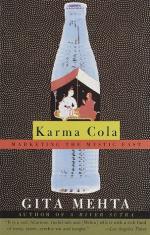|
This section contains 593 words (approx. 2 pages at 400 words per page) |

|
Karma Cola: Marketing the Mystic East Summary & Study Guide Description
Karma Cola: Marketing the Mystic East Summary & Study Guide includes comprehensive information and analysis to help you understand the book. This study guide contains the following sections:
This detailed literature summary also contains Topics for Discussion on Karma Cola: Marketing the Mystic East by Gita Mehta.
This book is an exploration of and commentary on the decades-long history of the West's search for spiritual enlightenment in the teachings of Eastern religions and philosophies. As she comments on the relationship between faith and commerce in this particular set of circumstances, the author considers the tendency towards, and growth of, exploitation on both sides, particularly as manifest in the expanding practice of using spirituality as a commodity.
The author introduces her analysis of the East/West spiritual relationship with commentary on a pair of myths that, she contends, explain the circumstances from which the mutual exploitation in that relationship emerged. She then, throughout the book, explores various facets, motivations, manifestations and repercussions of that exploitation.
Prominent among the specific aspects of eastern spirituality that the author considers is the idea of karma - specifically, the belief that many aspects of an individual's current life carry with them echoes of past lives and/or the foundations of aspects of future lives. The subject of karma is discussed with particular focus in Sections One and Two. In Section Three, the author introduces another of her central contentions, one related to her initial commentary on karma. This is the idea that the true nature and implications of eastern philosophy and teachings are often too profoundly different from their "home" philosophies for western seekers to handle. This thesis is reiterated and supported, on several occasions throughout the book, by anecdotal reportage of individuals who, as the result of contemplating eastern spirituality too closely or too intently, have either lost their grip on reality or gone into forms of denial.
Sections Four through Seven discuss ways in which individuals on both sides of the spiritual equation under consideration, both seekers and teachers, see what they want to see and act in response to those perceptions. Here the author begins her consideration of the exploitation that takes place on both sides of the equation, illustrating how both seekers and teachers are willing to exploit, and be exploited, in order to get what they believe they want. Many teachers, she contends, want money. Many seekers, she further contends, want any kind of spiritual enlightenment they can get. The brief Section Eight, meanwhile, takes a mostly anecdotal look at ways in which the spiritual gap between west and east can be bridged through other, non-exploitative means. Section Nine, however, contrasts the hope implied in Section Eight with a vivid, multi-leveled portrayal on how India's long history of exploitation by a number of different western natures has created what amounts to a culture of exploitation, grounded across the (decades? centuries?) in the illegal drug trade.
Section Ten examines the role and function of sexuality in both eastern spirituality and in triggering desire for explorations of/connection with that spirituality in the west. Section Eleven deepens that consideration with an examination of the sexual/sensual appeal of those on the darker, more corrupt, and ultimately more destructive side of the equation. In Section Twelve, the author reiterates her contention that the true nature of eastern philosophy and practice is ultimately too harsh for western seekers not only to understand and accept, but to want to understand and accept. Finally, in the brief Section Thirteen, the author holds out hope for future evolution of the east/west spiritual relationship, tempering it with the implication that both cultures have responsibility for creating the damage to that relationship, and both sides have a considerable way to go before a genuine, un-exploitative communion within that relationship can, and will, be realized.
Read more from the Study Guide
|
This section contains 593 words (approx. 2 pages at 400 words per page) |

|



